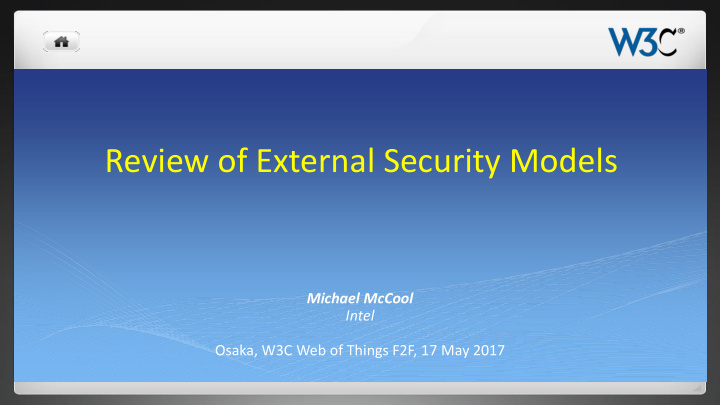



Review of External Security Models Michael McCool Intel Osaka, W3C Web of Things F2F, 17 May 2017
Purpose WoT charter: The scope of the Working Group is restricted to APIs and security frameworks that are applicable across platforms. We will not define new security mechanisms but will use existing mechanisms and best practices. 1. Determine how to gather requirements for external security models and standards 2. Determine how to represent information in a common format THEN b egin to review external security models and standards… 2/37
Outline List of external sources External standards Security models of important external IoT ecosystems WoT should interoperate with Anything missing we should add? Template for Threat model Other templates to consider Standards to review: IIC Security Framework IETF ACE Model 3/37
Sources See: https://github.com/w3c/wot/pull/319 Please create issues to suggest new references External References: Industrial Internet Consortium Security Framework: http://www.iiconsortium.org/IISF.htm IETF ACE (Authentication and Authorization for Constrained Environments): https://tools.ietf.org/wg/ace/ IETF RFC 7252 (CoAP) Security model: https://tools.ietf.org/html/rfc7252 STRIDE Threat Model OWASP IoT Attack Vectors Liaison References: OCF 1.0 Security Specification (Draft): https://openconnectivity.org/draftspecs/OCF_Security_Specification_v1.0.0.pdf Will discuss this during OCF Review on May 17 oneM2M Security Solutions, TS-0003: http://www.onem2m.org/images/files/deliverables/Release2/TS-0003_Security_Solutions- v2_4_1.pdf 4/37
Template for Threat Model Stakeholders Description, Role, Business-driven security goals, Interesting edge cases Assets Description, Who should have access (Trust Model), Attack Points Adversaries Persona, Motivation, Attacker type Attack surfaces System Element, Compromise Type(s), Assets exposed, Attack Method Threats Name, Adversary, Asset, Attack method and pre-conditions, priority Security Objectives and Non-Objectives Threats, Mitigation (if an objective), Reasoning (if not) 5/37
Other Templates? Protocol security frameworks and link Configuration management security Lifecycle management TLS, DTLS, etc. Logging and monitoring Encryption standards AES, RSA, etc. Privacy frameworks Identity, Authentication, and Integrity protection Authorization OAuth, etc. 6/37
IIC Security Framework See 7/37
IETF ACE See 8/37
Recommend
More recommend